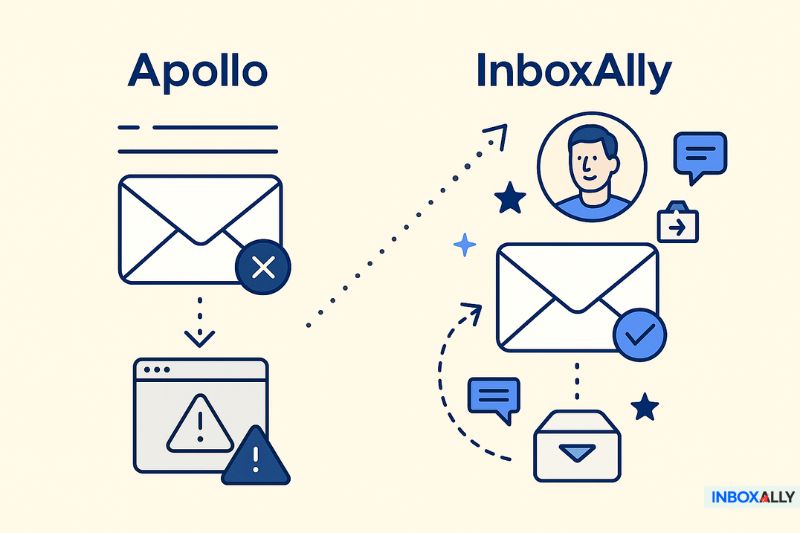Not only do we struggle with getting emails delivered, but we often misunderstand what “warmup” even means. Is it just pacing volume? Is it reputation building? Or is it something else entirely?
With Apollo shutting down its warmup feature, those questions suddenly became urgent. In this article, we’ll explain why warmup matters more than Apollo ever made it seem, what the main driver behind inbox placement is, and which alternatives are built for long-term deliverability.
But first, let’s slow down and ask: what does warmup really train, and why do inbox providers care?
Key takeaways
- Apollo’s warmup tool was never built for true deliverability
- When it shut down, marketers saw reply rates decline and campaigns stall.
- The change exposed how fragile outreach can be without proper warmup.
- The main lesson: inbox placement is built on credibility, not quick fixes.
Why is email warm-up so important?
![]()
A lot of senders treat warm-up like a box to tick before the “real” outreach begins. Truth is, it is the game, and deliverability depends on it.
Your prospects might see a clever pitch, but inbox providers see a stranger trying to get in. And strangers have to earn trust. Every sent email goes through spam filters, DNS checks, and your past track record. If you neglect warming up your mailing server, you’re essentially barging into an overflowing inbox unannounced, hoping not to be blocked on sight.
What inbox providers look for
The algorithms have one job: to protect users from spam. That means they analyze much more than message content. They check your domain reputation to see if your history suggests safe sending.
They verify DNS records to ensure your emails aren’t spoofed. They monitor bounce rates and complaint ratios to detect risky senders. And above all, they track where your emails land and how people interact with them. If those metrics look bad, your emails will be marked as spam, no matter how clever your email reads.
Warm-up as sender reputation training
Warmup is training, plain and simple. Training of email providers where you start small, build gradually, and let them see positive interactions: emails opened, replied to, saved from spam, and even archived.
These actions show trust, and over time, they teach inbox algorithms that your emails are safe, which improves your deliverability. That’s why warmup works by proving day after day that your domain belongs in the inbox.
When do you need to warm up a mailing server?
- Starting a new domain with no history
- Increasing your email volume past safe levels
- Fixing a damaged reputation from mistakes or complaints
- Recovering after being blacklisted
- Running cold outreach campaigns where trust is fragile
Warmup keeps you invisible to the wrong kind of attention and visible to the one you want. Without it, most cold email outreach attempts would fall apart before they even start.
InboxAlly vs. the Apollo way
Apollo’s warmup feature was never really the star of the show. The platform built its reputation around prospecting; scraping contacts, building sequences, automating outreach.
Deliverability was never its DNA, and it showed. When Apollo rebranded its feature as “Inbox Ramp Up,” it confirmed what many already suspected: the tool was about pacing, not reputation. That’s why so many senders saw campaigns stall despite “warming.” Without proper engagement, mailbox providers didn’t buy it.
Why Apollo was never built for deliverability
Since it’s always been lead generation-focused, Apollo was much better at speed, scaling, and automation. But warmup isn’t about how much you send, it’s about how trustworthy you look while sending.
Gmail and Outlook aren’t impressed by volume control. They look for engagement: opens, replies, and healthy interaction. Apollo’s warmup feature only dripped messages, and in practice, that meant inbox providers had nothing to latch onto. Volume was controlled, but reputation stayed the same.
How InboxAlly builds trust
InboxAlly starts from the opposite premise: deliverability first.
Every single warmup message gets handled like a real one. Opened, replied to, archived, rescued from spam folders. Those small actions are exactly the trust signals mailbox providers measure. And because its warmup progress is consistent and includes constant spam testing, the feedback loop slowly tilts in your favor as your domain stops looking risky and starts looking credible.
And it doesn’t stop when you’re “warmed.” Being an automated email warmup, InboxAlly keeps working in the background to maintain reputation so the trust you’ve built doesn’t collapse the moment you ramp volume.
You see inbox placement data, so you’re not guessing whether it’s effective. It’s warmup, plus monitoring, plus ongoing protection.
Advantages of InboxAlly over Apollo
- Engagement signals, not just pacing: every message is opened, replied to, or rescued.
- Inbox placement visibility: You can see where your emails land across email accounts in Gmail, Outlook, Yahoo, and more.
- Ongoing reputation protection: protection continues after warmup, not just before launch.
- Better deliverability outcomes: Fewer bounces, better domain reputation, and higher ROI for your cold email campaigns.
- Purpose-built for email health: InboxAlly’s entire focus is on inbox placement rates and sender trust.
InboxAlly doesn’t just replace Apollo’s old warmup. It redefines what warmup should mean. It’s less about slowing volume, more about building real credibility where it matters.
Other tools worth mentioning
InboxAlly isn’t the only name in the space, and there are a few other tools worth noting.
Warmup Inbox appeals to beginners. It’s simple to connect, offers a reputation score, and runs blacklist checks. It works fine for smaller setups, though it lacks depth for anyone managing multiple inboxes at a larger scale.
Warmbox is highly customizable for warm-up flow powered by AI-generated conversations. It allows for more control but comes at a higher cost and more complexity. If all you need is reliable inbox placement, it’s probably more than necessary.
Warmy is a volume-first platform built for aggressive senders. It can push thousands of warm-up emails per day and even supports multi-language campaigns. That scale is impressive, but the focus on numbers means it often overlooks the engagement signals that truly boost deliverability.
Inbox placement is the real KPI
If your cold outreach turns into a “numbers game,” where sending more becomes the focus rather than sending better, you’re on a slippery slope toward spamming. That’s why your focus should be on quality, rather than sheer numbers.
No matter how much volume you do, a clean, targeted list with verified addresses and relevant prospects consistently brings higher open rates (30–50% vs. <10% on scraped lists), better reply rates (often 3-5x better), and ultimately more conversions per 100 emails sent. InboxAlly replicates those same high-quality interactions during warmup so your inbox builds trust and delivers better results. You can try InboxAlly for free here to see it in action.
The risks of skipping warmup
Ignoring warmup puts risk on more than a dip in email performance. Bounce rates shoot up, domains get flagged, and campaigns fall apart before they even get going. Once you’re blacklisted, getting back in takes time, effort, and money.
Some signs your deliverability is worsening include:
- Spam complaints rising, even when volume is low
- Bounce rates are spiking, showing your domain or IP is losing trust
- Reply rates are falling while you’re still sending at the same level
So before you dismiss warmup as a vanity step, remember that what separates campaigns that fail from those that convert is often the patience you’ve put into building trust.
The reset Apollo forced on email outreach
Apollo’s shutdown didn’t just close a feature; it forced a reset in email marketing.
For years, marketers leaned on an email warmup tool that was never truly built for deliverability improvement. When it disappeared, the cracks became obvious, and we all learned that volume control isn’t reputation, and pacing isn’t placement.
That disruption, as painful as it felt, was also necessary. It pushed everyone to stop relying on half measures and start using platforms built for proper inbox trust. The result is a market that’s moving toward better practices, better tools, and a better understanding of what email deliverability requires.
In hindsight, Apollo’s exit was the push email senders needed to take inbox placement seriously.
Wrapping it up
Apollo may be gone, but inbox-ready sending isn’t. The shutdown was a reminder that deliverability is fragile, and that it takes more than a basic warmup to keep campaigns alive.
Some platforms promise shortcuts or flashy features. InboxAlly stays consistent in the one thing that matters: showing inbox providers your emails deserve to be seen.
If placement is important to your outreach, this is the tool worth building on. Try InboxAlly for yourself, and start turning cold sends into real conversations.


